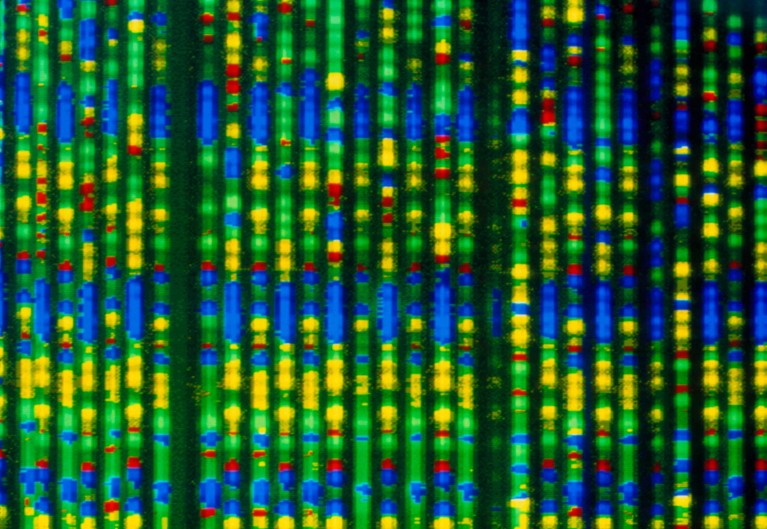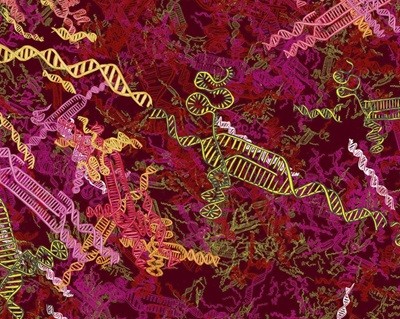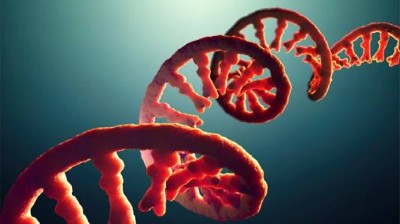
Base editors can modify a DNA sequence (shown here in a coloured autoradiogram) at specific target sites, allowing disease-causing mutations to be corrected.Credit: Hank Morgan/Science Photo Library
Late last year, dozens of researchers spanning thousands of miles banded together in a race to save one baby boy’s life. The result was a world first: a cutting-edge, gene-editing therapy fashioned for a single person, and produced in a record-breaking six months1.
Now, baby KJ Muldoon’s doctors are gearing up to do it all over again, at least five times over. And faster.
The groundbreaking clinical trial, described on 31 October in the American Journal of Human Genetics2, will deploy an offshoot of the CRISPR–Cas9 gene-editing technique called base editing, which allows scientists to make precise, single-letter changes to DNA sequences. The study is expected to begin next year, after its organizers spent months negotiating with US regulators over ways to simplify the convoluted path a gene-editing therapy normally has to take before it can enter trials.
Developing KJ’s treatment was “a pretty hectic and intense six months”, says Kiran Musunuru, a cardiologist at the Perelman School of Medicine at the University of Pennsylvania in Philadelphia, and one of KJ’s doctors. “But I think we can get it shorter.”
CRISPR genome-editing grows up: advanced therapies head for the clinic
The trial is also the next step towards answering a question that has hung over many families of children with rare diseases since the news broke of KJ’s successful treatment: when will it be our turn? “There is no ‘one size fits all’ in this space,” says Ryan Maple, executive director of the Global Foundation for Peroxisomal Disorders in Tulsa, Oklahoma.
Momentum seems to be building. In addition to the planned clinical trial in Philadelphia, the Center for Pediatric CRISPR Cures, which launched in July at the University of California, Berkeley and the University of California, San Francisco, also aims to develop personalized gene-editing therapies. And in September, the US government’s Advanced Research Projects Agency for Health announced two programmes to fund research into the development and manufacturing of “precision genetic medicine”.
“I’m more optimistic now than I have been in the past,” says Joseph Hacia, a medical geneticist at the Keck School of Medicine at the University of Southern California in Los Angeles.
Therapy for one
In August last year, soon after KJ Muldoon was born, doctors realized that he had a genetic mutation that meant he was unable to produce the normal form of a crucial liver enzyme called carbamoyl phosphate synthetase 1 (CPS1). CPS1 detoxifies ammonia, a natural waste product formed when the body breaks down protein. Ammonia can damage the brain if it is not removed from the bloodstream, and many children with CPS1 deficiency do not live long enough to receive the only known cure: a liver transplant.
But one of KJ’s doctors, Rebecca Ahrens-Nicklas at the Children’s Hospital of Philadelphia in Pennsylvania, had been working with Musunuru to develop a base-editing therapy that could be deployed rapidly to treat children with metabolic disorders. KJ would become their first case.
Move over, CRISPR: RNA-editing therapies pick up steam
In late February, KJ received a base-editing therapy designed for him, and him alone. CPS1 deficiency occurs in around one in a million births. The therapy KJ received was designed to find one of the incorrect letters in the DNA sequence of his CPS1 gene and replace it with a different letter that would allow the full CPS1 protein to be produced.
After the therapy, KJ’s ammonia levels dropped, and he was able to reduce his medications. Since then, he’s been hard at work, learning to stand on his own, eating solid foods and working towards taking his first steps. “We celebrate each milestone that KJ accomplishes,” says his mother, Nicole Aaron. “He has a radiance about him that really brightens up every room he enters.”
.png)




